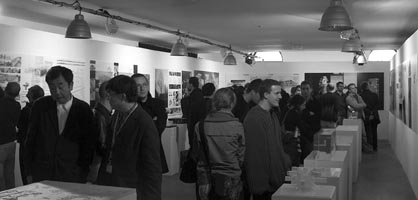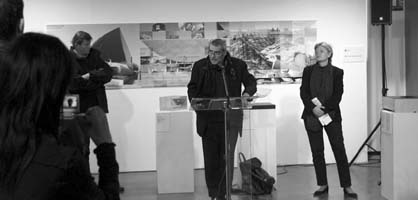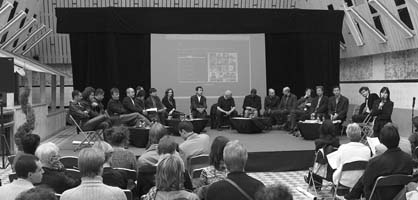|
|
| home > files |
| New
Trends of Architecture in Europe and Asia-Pacific Rei Maeda |
||||
| Una
situazione favorevole, rara e preziosa, per portare sul piano del confronto
internazionale non solo la qualità degli esiti, ma anche i caratteri
molteplici di una dimensione professionale complessa, potenzialmente
ricca. Michele Bonino ha seguito, nello scorso autunno, l’appuntamento
con New Trends a Lille.
Presente ELASTICO, unico gruppo italiano partecipante, di cui ARCH'IT
propone il progetto per piazza
Mercatale a Budoia. L’iniziativa New Trends of Architecture
in Europe and Asia-Pacific, basata su un sistema itinerante di esposizioni
e congressi, evidenzia la pratica dello scambio su differenti livelli.
Abbiamo chiesto a Rei Maeda, coordinatrice del progetto, di raccontare
il percorso fin qui seguito e, alla luce del riscontro ottenuto, delinearne
le prospettive. |
||||
| "New
Trends of Architecture in Europe and Japan" was launched in 2001
when the EU and Japan declared to designate the first 10 years of the
new millennium as the "Decade of Japan-European Cooperation".
Following this declaration, the European Press and Cultural Counselors
Group in Tokyo decided to organize an architectural exhibition series
where the diversity of cultures and future common challenges could be
fruitfully presented and discussed, and asked us Art Front Gallery to
be committed to the project as the Secretariat, considering our experiences
in international projects, including "Echigo-Tsumari Art Triennial"
www.echigo-tsumari.jp The reason is evident why the European diplomats chose 'architecture' as a field for EU-Japan exchanges. Japan has a large pool of architectural talent and has a great amount of creative activity in architecture even when compared with other genres of art such as fine art. With the aim of deepening understanding and relation between Europe and Japan, the first in a series brought fifteen promising European architects from the fifteen EU member States to display their work and share their ideas and experiences with their Japanese counterparts through the exhibition and symposium which took place in Tokyo and the Cultural Capitals of Europe, Porto and Rotterdam. The second edition was held in Tokyo, Ghent, Salamanca (Capital of Culture 2002), Bordeaux, Lisbon and Madrid.  In this year 2004, when the EU welcomed 10 new member states, "New Trends of Architecture" has been restructured as biannual and been expanded from "EU-Japan" to "EU-Asia-Pacific". For this third edition, Slovenia is represented from the new member states, while China, Hong Kong, Korea, Malaysia and Australia newly represent the Asia-Pacific region. "New Trends of Architecture in Europe and Asia-Pacific 2004-2005" was inaugurated very successfully in Lille, Cultural Capital 2004 in October-November, and will take place in Hong Kong soon from 5th to 19th January, 2005. Today, there are many international events, like exhibitions, symposium and workshops throughout the world, which allow architects to enjoy frequent opportunities to meet and interact going beyond borders. This "New Trends of Architecture" project is also among them. However, this project can be called an unprecedented endeavor in various points. The first point lies in that the project emphasizes "exchange" on different levels. The architects are not only demanded to present their works for the exhibition, but also to attend the events which are organized in each venue. They repeat their meetings and discussions during the exhibition traveling in Europe and Asia-Pacific. The local organizers are given a free hand to decide the format and the theme of the symposium, considering their local context. For example, in Lille, 18 groups of architects from Europe and Asia-Pacific were brought together to attend the opening program which took place for 2 days on 8th and 9th of October. Lille 2004 organized a workshop entitled "New cultural sensitivities. New place of culture? Example of the Maisons Folie" to think about the new cultural places and the role of the architect. Lille 2004 had renovated a dozen historical and industrial patrimonies into cultural facilities called "Maisons Folie" in the process of making the Cultural Capital. For the workshop, they programmed a guided bus tour to visit three Maisons Folie, which provided opportunities for the architects to spend time together and deepen the conversations amongst themselves, during moving in the bus, having food and drinks. We can say that such 'informal' occasions are as interesting and important as the public programs in respect of 'exchange'. Also, the architects enjoyed exchanges with the locality.  In Tokyo, in conjunction with the opening of the first edition in 2001, we called for professor-architects' inviting European architects to their universities. In response to our call, 17 universities invited the European architects to give a lecture or workshop for students not only in Tokyo but also in Sendai, Nagoya, Kyoto and other cities. For the students, it was an exciting experience to communicate and exchange with younger architects, as most of the architectural exhibitions in Japan, in particular those introducing foreign architects, focus on 'already established architects" who are far apart from them. This university lecture program brought about a sort of movement among students (please imagine that a dozen lectures happened simultaneously on the same day throughout Japan), and a network of universities has been created. This program is still going on. The second point is that architects select architects. To select the participating architects, we have invited prominent architects as Commissioners: Alvaro Siza, Fumihiko Maki, Wiel Arets, Toyo Ito, Alejandro Zaera Polo, Bob van Reeth, Dominique Perrault, Hiroshi Hara.... There is a way of inviting a curator or a critic as commissioner to make an exhibition, but we wanted to introduce a sense of a 'practician' into this project. The commissioning architects are required to select the architects not only from their familiar countries but also from their unfamiliar ones. Through researches and discussions made in cooperation with their friends (architects, critics, curators, etc.), they come to a final list of architects, which reflects their opinion on the actual 'trend' in architecture, as well as their anticipation for the new generation. I recall an impressive scene of the symposium which took place in Tokyo in 2001. To conclude the symposium, Mr. Fumihiko Maki showed one slide after summarizing and analyzing the discussions held during the day. It was a monochrome picture showing a scene of Team Ten's workshop, where a group of young architects were discussing in a casual manner while their wives were knitting behind them. Mr. Maki as a youth and his wife also appeared in the picture. I was a little embarrassed and very much moved by his act rather than by the picture itself. Against the slide image, he said that it was very important for his life to meet the architects of the same generation. He also mentioned that the relationship and the network made through Team Ten's activity had supported his career and himself. His words sounded an encouragement for the younger generations, and then I recognized the goal of our "New Trends" project. It aims neither at showcasing trends of architecture nor at making architects of different countries compete, but at creating a forum and a network for the coming generations.  The third consists in that this project has been conceived in the framework of European Capital of Culture. This system represents the ideal of the European Union, which respects cultural diversity while unifying the European continent in political and economical terms. It tells us the dynamism of Europe where the direct relationship between cities is being built through culture, and inspired us to extend this project to the Asia-Pacific region. In contrast to politics and economy, culture cannot be relatively evaluated. That is why every city can be the capital of culture, even if it cannot be a political capital. In fact, there are many delicate and complex problems between Asian cities, but culture, including architecture, can play a role to connect people to people, city to city. The forth and last point is the fact that this project has no big sponsor. It is made possible by the host cities sharing the common cost to build up the exhibition. Each city is required to contribute its share as a project partner. It is not easy for the host cities to shoulder a part of the total cost in addition to their local cost, while it is a tough work for us to persuade them to take part in the financial structure of the project. However, this process is critical in making this project feasible and in turning it to be a true international collaboration. The exhibition continues to travel from Hong Kong to Tokyo, Cork (Cultural Capital 2005) and Melbourne, while bringing about happenings in each venue and networking the cities on the way. Now it's about time to start calling for the next edition: 2006-2007. I hope that more cities will respond to our call and join us in this thrilling journey. Rei Maeda Coordinator, New Trends of Architecture in Europe and Asia-Pacific |
[04jan2005] | |||
| >
SOPRALLUOGHI: MICHELE BONINO: NEW TRENDS A LILLE > ARCHITETTURE: ELASTICO + MARCO BRUNO > NEW TRENDS OF ARCHITECTURE IN EUROPE AND ASIA-PACIFIC |
||||